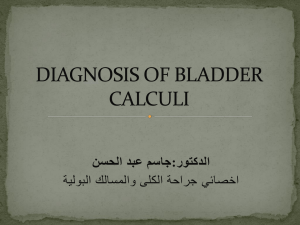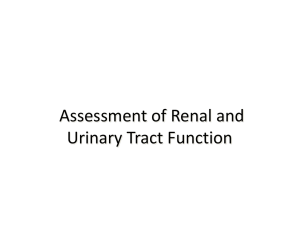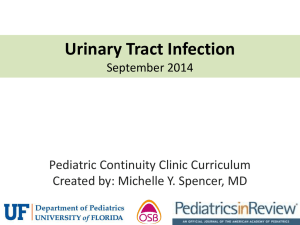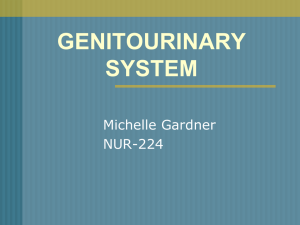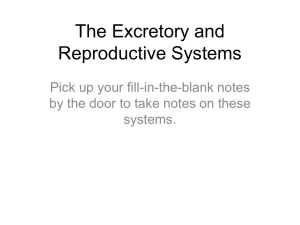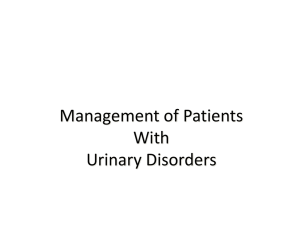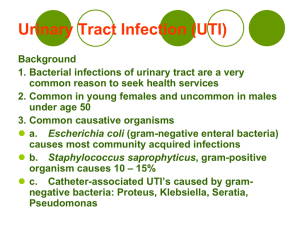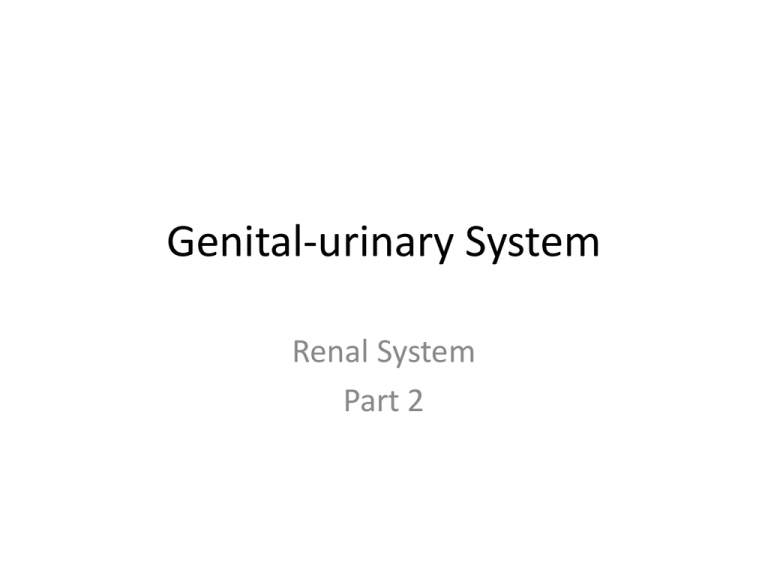
Genital-urinary System
Renal System
Part 2
Behavioral Objectives
•
Identify and describe the etiology, pathophysiology, clinical manifestations, nursing management and
patient education for the following:
–
–
–
–
•
•
•
Urinary retention
Urinary incontinence
Urinary suppression
Residual urine
Discuss common pharmacological interventions appropriate in treatment of patient with GU disorders
Describe general nursing consideration and intervention in pre and post-operative care of patients
undergoing urological surgery
Describe etiology, pathophysiology, clinical manifestations, nursing management and patient education for
the following GU disorders:
–
–
–
–
–
–
–
–
Pyelonephritis
Cystitis
Urinary tract infections (UTI)
Urethritis
Nephritic syndrome
Hydronephrosis
Renal calculi
Renal neoplasm’s
Dysfunctional Voiding Patterns
•
Urinal Incontinence
•
Pathophysiology
–
–
–
Unplanned loss of urine that is sufficient to be considered a
problem
Continence requires intact urinary, neurologic and muscularskeletal systems
Any break in communication between these systems can lean to
incontinence (or residual)
Types of Incontinence
•
Stress Incontinence
–
–
–
Involuntary loss of urine through an intact
urethra due to a sudden h in intra-abd.
pressure
Treatment-mild: Biofeedback & bladder drills
Treatment-moderate to severe: surgery
•
Pelvic Floor Training and the role of Biofeedback: Health Care Professionals usually advise
Pelvic Floor Training as a first line treatment or an adjunct therapy for urine leakage that
occurs during coughing, laughing or on exertion. Pelvic floor exercises are effective, but only
if carried out regularly and diligently. The lack of feedback on progress may lead to frustration
and the discontinuation of an exercise routine, hence, it is prudent to choose
devices/exercisers with biofeedback function, such as Peritron Perineometer and PFX range
of pelvic floor exercisers with pressure biofeedback. The challenge is to motivate and
encourage the workout and simultaneously ensure exercising of the correct muscles.
Appropriate feedback will stimulate discipline and step-wise progress. PFX is available in 2
versions - vaginal for women only and anal that can used by both men and women. PFX and
Peritron Perineometer products can help people, who wish to monitor the effectiveness of
their exercising efforts, because of the valuable biofeedback that they generate. Pelvic floor
exercises should become routine events in women's lives, but especially before and after
childbirth, hysterectomy and the menopause
.
Types of Incontinence
•
Urge Incontinence
–
Involuntary loss of urine associated with a
strong urge to void that cannot be suppressed.
Treatment-
–
•
•
•
•
Biofeedback
Pelvic floor nerve stimulation
Bladder drill
Anticholinergics
anticholinergic
• An anticholinergic agent blocks the
neurotransmitter acetylcholine in the central
and the peripheral nervous system.
• An example dicyclomine.
• Decreased the effects mediated by
acetylcholine on acetylcholine receptors
Types of Incontinence
•
Reflux incontinence
– Involuntary loss of urine due to Hyperreflexia in
the absence of normal sensation
– Associated with spinal cord injuries
Types of Incontinence
•
Overflow incontinence
– Involuntary loss of urine due to over-distention
of the bladder
•
•
•
•
Bladder is unable to empty normally
over distended
frequent urination (just over flow)
Incontinence
– Treatment:
•
Catheterization
Behavior Therapy Management
•
Fluid Management
– Increase fluid
– Decrease fluid
– WATER!!!!
•
Standardized voiding frequency
•
•
Timed voiding
Bladder retraining
Behavior Therapy Management
•
Pelvic Muscle
Exercises
–
Kegel exercises
•
Goal
–
strengthen
voluntary muscles
Behavior Therapy Management
•
Pharmacological Therapy
–
Anticholinergic agents
•
Oxybutynin/Ditropan
–
–
Action: Inhibits bladder contractions
Indications for use: urge incontinence
Surgical management
•
Involve lifting and stabilizing the bladder or
urethra
Nursing Management
h fluids
No diuretics after 4PM
Avoid bladder irritants
•
•
•
–
–
–
•
•
•
•
Caffeine
Alcohol
Aspartame (nutrasweet)
High fiber meals
Void regularly
Enc pelvic floor exercises
Stop smoking
Urinary Retention
•
Pathophysiology
–
Urinary Retention
•
–
The inability to empty the bladder completely
Residual urine
•
–
urine that remains in the bladder after voiding
Assoc. with
•
•
•
•
•
•
•
post-op d/t reflux spasm of sphincters
Diabetes
Prostatic enlargement
Urethral pathology
Trauma
Pregnancy
Neurologic disorders
Urinary Retention
•
Assessment
–
Measure post void
residual urine
•
Portable bladder
scanner
Urinary Retention
•
Complications
–
–
–
–
–
Chronic infections
Pyelonephritis
Sepsis
Kidney failure
Deathmosis
Urinary Retention
•
Nursing Management
–
Promoting normal urinary eliminations
•
•
•
•
•
•
•
•
–
Provide privacy
Commode
Male stand
Sitz bath
Hot tea
Water faucet on
Tapping pubic area
Dipping hand in warm water
Promoting urinary elimination
•
Catheterization
Neurogenic Bladder
•
•
A dysfunction d/t a lesion of the nervous system
Two types of neurogenic bladder
–
Spastic bladder / reflex bladder
•
–
Empties on reflex
Flaccid bladder
•
•
•
•
Bladder becomes distended
Overflow incontinence
Bladder does not contract
Can not feel discomfort
Neurogenic Bladder:
Management
•
Catheterization
–
–
–
–
–
•
Indwelling devices
–
–
–
•
Obstruction
Post-op
Monitor output with critical
Neurogenic bladder or urinary retention
Stage III or IV decubitus ulcers
Drainage bag below the level of the bladder
Tubing not kinked and no too long
Increase fluids
Suprapubic catheterization
Urological Surgery
• Drainage tubes
• Nephrostomy drainage
– Tube inserted directly into the kidney
Nephrostomy drainage
• Nursing management
– Assess for complications
• Bleeding
• Infection
• Skin
–
–
–
–
–
–
Ensure unobstruction
Never clamp
Irrigate
Encourage fluids
Aseptic technique
Measure I&O
Urethral Stent
•
A tubular device that maintains position &
patency of the urethra
Nursing Process:
post-op urinary surgery
• Ineffective airway clearance r/t the surgical incision
• Ineffective breathing pattern r/t to surgical incision &
general anesthesia
–
–
–
–
–
–
–
Assess resp status
Auscultation
Admin analgesics
Splint
Change position frequently
Incentive spirometer
Amb.
Test Question!
–
Which of the following is appropriate nursing
interventions for a patient with a nursing diagnosis of
ineffective breathing patterns following renal surgery?
A.
B.
C.
D.
E.
Have the patient lay on affected side most of the time
Encourage short breaths so not to strain incision site
Bed rest
Administer analgesics
None of the above
Nursing Process:
post-op urinary surgery
•
Acute pain
–
–
–
–
–
–
–
Assess pain level
Assess abd. distention
Admin analgesics
Moist heat
Massage
Splint
Exercise
Nursing Process:
post-op urinary surgery
•
Urine retention r/t pain, immobility and anesthesia
–
–
–
–
–
–
–
–
Asses I&0
Assess drainage & drainage system
Aseptic technique
Maintain closed system
Irrigate?
Enc pt to move – assist to move
Anchor cath
Fluids
Nursing Process:
post-op urinary surgery
•
Potential complications
–
–
–
–
–
Bleeding
Pneumonia
Infection
Fluid disturbances
Deep vein thrombosis
Urinary tract infections (UTI)
•
Describe etiology, Pathophysiology, clinical
manifestations, nursing management and patient
education for Urinary tract infections (UTI)
–
Pathophysiology
•
•
•
UTI’s are caused by pathogenic micro-organisms in the urinary
tract
Bacteria in bladder attach to the bladder colonizes in the
epithelium
E. Coli
Urinary tract infections
• Reflux
– Backward flow of urine from the urethra to the
bladder
•
•
•
•
•
•
Cough
increase bladder pressure
urine forced into urethra
stop coughing
decreased pressure
urine flows back into bladder
Urinary tract infections
•
Types of UTI’s
–
Cystitis –
•
–
Inflammation of the bladder
Prostatitis –
•
–
Inflamation of the prostate gland
Urethritis –
•
–
Inflammation of the urethra
Pyelonephritis –
•
–
Inflammation of the renal pelvis parenchyma
Interstitial nephritis –
•
Inflammation of the kidney
Defense Mechanism
•
•
•
•
Physical barrier
Urine flow
Enzymes
Antibodies
Defense Mechanism
• Who is more likely to get a UTI
– Male
– Female
• Why?
– Shorter urethra
Predisposing factors to UTI
•
•
•
•
•
Factors increasing urinary stasis
Foreign bodies
Anatomic factors
Factors compromising immune system
Functional disorders
Clinical Manifestations:
Lower UTI
•
•
•
•
Dysuria
Burning
Frequency
Urgency
–
–
–
–
–
–
Nocturia
Incontinence
Pelvic pain
Hematuria
Cloudy urine
Back pain
Clinical Manifestations:
Upper UTI
•
•
•
•
•
•
Fever & Chills
Back pain (flank)
N/V
H/A
Malaise
Dysuria
Gerontologic considerations
•
•
•
•
Few S&S
Fatigue
Alt cognitive function
Slight drop in temp
Assessment & Dx findings
• UA
• Culture
Medical management/
pharmacological therapy
• Antibiotic
– Cephalosporin
– Bactrim/Septra
• Urinary analgesic
– Phenazopyridine
(Pyridium)
• Urine orange
Nursing Process: UTI
• Assessment
– S&S
– Voiding patterns
– Sexual intercourse
– Urine
Nursing Process: UTI
•
Diagnosis
–
–
–
Acute pain related to inflammation of the urinary tract
Assess pain
Admin. Analgesics
•
–
Teach non-Rx
•
•
–
Tell pt orange
Heating pad
Warm showers
Admin antispasmodics
Nursing Process: UTI
• Diagnosis
– Deficient knowledge detection, preventions and
recurrence and meds
• Hygiene
• Fluid intake
• Voiding habits
Nursing Process: UTI
• Nursing Interventions: Hygiene
– Shower not bath
– Front to back
– Wash after BM w/soap & water
– No harsh soaps
Nursing Process: UTI
• Nursing Interventions: Fluid Intake
– Increased
– Water
– Avoid irritants
•
•
•
•
•
•
Coffee
Tea
Citrus
Spices
Cola
Alcohol
Nursing Process: UTI
• Nursing Interventions: Voiding habits
– 2-3 hrs
– Empty completely
– Before & after intercourse
Pyelonephritis
•
Bacterial infection of the renal pelvis,
tubules and interstitial tissue of one or
both kidneys.
–
Pathophysiology
•
•
•
•
Lower ascends up
Reflux
Obstruction
enlarged kidney
Pyelonephritis
•
Clinical manifestations
–
–
–
–
–
Acutely ill
Fever & Chills
Pyuria
Flank pain
Bacteriuria
Pyelonephritis
• Assessment & Dx:
– Ultrasound
– CT
– UA
•
•
•
•
Pyuria
Bacteriuria
Hematuria
WBC
Pyelonephritis
• Medical Management
– Outpatient
– Dehydration
Pyelonephritis
• Rx
– 2 week antibiotics
– IV
Pyelonephritis
•
Complications
–
–
–
–
End Stage Renal Disease
Hypertension
Kidney stones
Urosepsis
Urethritis
•
Pathophysiology
–
–
–
Inflammation of the urethra
Usually ascending infection
STD
Urethritis
•
Clinical manifestations – Men
–
–
–
–
•
Prostatitis
Epididymitis
Urethral stricture
Sterility
Clinical Manifestations - Women
– Asymptomatic
Urethritis
• Treatment
– Tetracycline
– Partners
Nephrotic syndrome
•
Pathophysiology
–
Primary glomerular disease characterized by:
•
Marked increase in protein in the urine
–
•
(proteinuria)
Decrease in albumin in the blood
–
(hypoalbuminemia)
•
Edema
•
High serum cholesterol and low-density lipoprotein
Nephrotic syndrome
–
Clinical Manifestation
•
•
•
•
•
#1 – edema
Malaise
H/A
Irritability
Fatigue
Nephrotic syndrome
•
Assessment and diagnostic findings
–
–
–
Proteinuria
Hyperlipidemia
Hypoalbuminemia
Nephrotic syndrome
• Complications
– Infections
– Thromboembolism
– Pulm. Emboli
– Renal Failure
Nephrotic syndrome
• Medical Management
– Diuretic
– NSAID
– Diet
•
•
•
•
i
h
h
i
Sodium
K+
protein
Fat
Nephrotic syndrome
• Nursing Management - Edema
– qD weight
– I&O
– Abd. Girth
– Clean skin
– Avoid people with infections
Hydronephrosis
•
Pathophysiology
–
Dilation of the
renal pelvis and
calyces of one or
both kidneys due to
an obstruction
Hydronephrosis
• Clinical Manifestations
–
–
–
–
–
Aching flank
Dysuria
Chills & fever
Tenderness
Pyuria
Hydronephrosis
• Medical Management
– Remove obstruction
Renal calculi or nephrolithiasis
•
Pathophysiology
–
Stones are formed in the urinary tract when
urinary concentrations of the substances such
as calcium oxalate, calcium phosphate and uric
acid increase
•
•
Calculus = Stone
Lithiasis = Stone formation
Renal calculi or nephrolithiasis
• Certain factors favor the formation of stones:
– Infection
– Urinary stasis
– Immobility
– Dehydration
Renal calculi or nephrolithiasis
• Clinical Manifestations
– Pain
• Abd / flank
• Severe
• N&V
– Hematuria
Renal calculi or nephrolithiasis
•
Assessment and
diagnostic findings
–
–
–
–
–
X-ray
Ultrasonography
24-hour urine test
Cystoscopy
IVP
Renal calculi or nephrolithiasis
• Cystoscopy
– Lighted scope to inspect
bladder
– Gen anesthesia
– Nrs Management
•
•
•
•
•
Force fluids
Expect burning
Pink tinged
Frequency
Orthostatic hypotension
Renal calculi or nephrolithiasis
• IVP
– intravenous pyelogram
– X-ray + IV dye
– Assess for allergies to
dye
– After push fluids
Renal calculi or nephrolithiasis
•
Medical management
–
–
–
–
Opioid analgesic
Antibiotics
NSAIDs
Diet
•
•
•
•
Calcium OK
Fluids
i protein
i Sodium
Renal calculi or nephrolithiasis
•
Surgical
Management
–
–
If > 4mm will not
pass through ureter
If not pass
spontaneously or if
complications
surgery
Renal calculi or nephrolithiasis
Surgical Management
• Ureteroscopy
– First visualize the stone
– Destroy the stone
• Laser
• Electrohydraulic
lithotriptos
• Ultrasound
Renal calculi or nephrolithiasis
•
ESWL Extracorporeal
shock wave
lithotripsy
–
–
Gen / spinal
Shock waves
water stone
breaks up
Renal calculi or nephrolithiasis
•
Nursing Process
–
Diagnosis
•
•
Acute pain
Deficient knowledge to prevent recurrence of renal
stone
Renal calculi or nephrolithiasis
• Nursing Interventions
–
–
–
–
–
–
–
–
–
–
Admin opioid agents
NSAIDS
Position of comfort
Amb.
Heat to flank
h fluids
Assess urine
I&O
Strain urine – gauze
Avoid dehydration
Renal neoplasm’s
•
Pathophysiology
–
–
Tobacco leading cause of all UT – Ca
Metastasize early
•
•
•
•
–
Liver
Lungs
Bone
Brain
1/3 have metastasis at time of diagnosis
Renal neoplasm’s
• Clinical Manifestations
– Asymptomatic
– Painless hematuria
Renal neoplasm’s
• Medical treatment
– Goal:
• Eradicate before metastasis
• Nephrorectomy
• Chemotherapy


